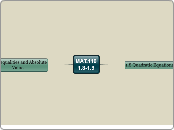MAT.116
1.8-1.9
1.8 Quadratic Equations
Quadratic Equations
A quadratic equation in one variable can be written in the form ax^2+bx+c=0 (a not zero). This is called standard form.
Solving by Factoring
Zero-Product Property of Real Numbers:If a and b are real numbers and ab=0, then a=0, or b=0, or both a,b=0.
Solving by Completing the Square
Begin with the quadratic equation in standard formax^2 + bx + c = 0Rewrite the equation into the equivalent formx^2 + (b/a)x = -(c/a)Add (b/2a)^2 to both sides of the equationx^2 + (b/a)x + (b/2a)^2 = -(c/a) + (b/2a)^2Factor the left side into a perfect square and add the right-hand side togther(x + b/2a)^2 = (b^2 - 4ac) / 4a^2Use the square root principle and solve for xx + b/2a = +-sqrt((b^2 - 4ac) / 4a^2)x = -b/2a +- sqrt((b^2 - 4ac) / 4a^2)
Using the Quadratic Formula
Given a quadratic equation in standar form,ax^2 + bx + c = 0 (a not zero),we can solve the equation using the quadratic formula -b +- sqrt( b^2 - 4ac )x = -------------------------2a
Solutions
The disciriminant of the quadratic equation isb^2 - 4ac.If the discriminant is positive, the equation has two distinct real solutions.If the discriminant is zero, the equation has one real solution.If the disciminant is negative, the equation has no real solutions.
1.9 Inequalities and Absolute Value
Intervals
Vocabulary
Finite intervalsOpen intervalsClosed intervalsHalf-open intervalsInfinite intervals
Notation
Finiteopen: (a,b)closed: [a,b]half-open: (a,b]half-open: [a,b)Infiniteopen: (a,infinity)half-open: [a,infinity)open: (-infinity,a)half-open: (-infinity,a]open: (-infinity,infinity)
Inequalities
Symbols
< less than (strictly less than)> greater than (strictly greater than)<= less than or equal to>= greater than or equal toEquivalent symbols:Open: < > ( ) open circleClosed: <= >= [ ] closed circle
Properties
Let a, b, and c be any real numbers.If a<b and b<c, then a<c.If a<b, then a+c<b+c.If a<b, then a-c<b-c.If a<b and c>0, then ac<bc.If a<b and c<0, then ac>bc.These properties are also true for >, >=, and <=.
Solving
A real number is a solution of an inequality in one variable if a true statement is obtained when the variable is replaced by that number.The set of all real numbers satisfying the inequality is called the solution set.Solution sets for inequalities in one variable can be written in inequality notation, set notation, and interval notation, and they can be graphed on a number line
Polynomial and Rational Inequalities
A graphing calculator is a good tool to assist with the solution of nonlinear inequalities.
Absolute Value
Definition
The absolute value of a number a is denoted by |a| and is defined by|a| = { a if a>=0 { -a if a < 0Absolute value represents the distance a real number is from 0 on the number line. Absolute value is always nonnegative.
Properties
If a and b are any real numbers, then|-a|=|a||ab|=|a||b||a/b|=|a|/|b||a+b|<=|a|+|b|
